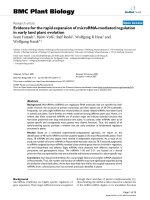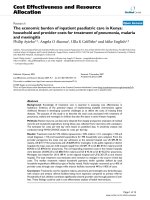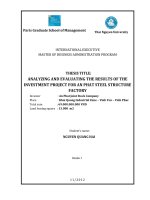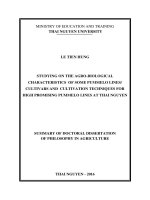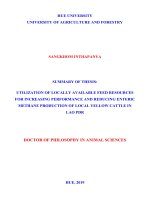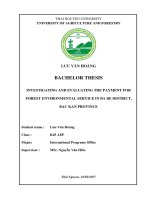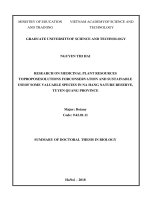Pyramided ph2 and ph3 genes for breeding tomato tolerant to late blight and evaluating the horticultural characteristics of some tomato lines in early winter season 2020 in red river delta
Bạn đang xem bản rút gọn của tài liệu. Xem và tải ngay bản đầy đủ của tài liệu tại đây (1.66 MB, 72 trang )
VIETNAM NATIONAL UNIVERSITY OF AGRICULTURE
FACULTY OF AGRONOMY
GRADUATION THESIS
Pyramided Ph2 and Ph3 genes for breeding tomato
tolerant to late blight and evaluating the horticultural
characteristics of some tomato lines in early winter
season 2020 in Red River Delta
Student
: Nguyễn Xuân Khánh
Student code
: 611609
Class
: K61KHCTT
Department
: Genetic and plant breeding
Supervisors
: Assoc. Prof. Vũ Thị Thu Hiền
Dr. Trần Ngọc Hùng
Ha Noi, 2021
COMMITMENT
I hereby commit that the research data and results in this paper are honest and have
never been used in any reports before. I declare that the references in the thesis are cited
and not been published in any research.
Hanoi, 28th February, 2021
Student
Nguyen Xuan Khanh
i
ACKNOWLEDGEMENTS
In performing my undergraduate thesis, it is a successful one I had to take the help
and guideline of some respected persons.
First and foremost, I would like to express my sincere gratitude to my supervisors,
Assoc. Prof. Vũ Thị Thu Hiền -Head of Department of Genetic and Plant breeding,
Vietnam National University of Agricultural (VNUA) and Dr. Trần Ngọc Hùng-Head of
Department of Biotechnolog, Fruit and Vegetable Research Institute, for the continuous
support of my graduation thesis, for their patience, motivation, and immense knowledge.
Their devoted guidance helped me in all the time of research and writing of this thesis.
Besides my supervisors, I would like to thanks to The Fruit and Vegetable
Research Institute for giving me an opportunity to access to the laboratory and research
facilities. In the other hand, I am also grateful to people working in here for sharing their
experiences, time during my work. Without their precious support, it would not be
possible to conduct this thesis.
I would also like to express my indebtedness to all the teachers who taught me
during the past studying and equipped me with the knowledge as the basis for conducting
my thesis as well as in real life.
My sincere thanks also go to teachers in faculty of Agronomy, Vietnam
National University of Agriculture for their insightful comments and encouragement.
Besides that, I am thankful to my dear classmates, class K61KHCTT, for all
the fun, friendship we had in the last four years.
Last but not least, I would like to thank my family for supporting me
spiritually throughout my studying and life in general.
Hanoi, 28th February, 2021
Student
Nguyen Xuan Khanh
ii
TABLE OF CONTENT
COMMITMENT
ACKNOWLEDGEMENTS
TABLE OF CONTENT
LIST OF TABLES
LIST OF FIGGURE
ABSTRACT
I
II
III
VII
VIII
IX
CHAPTER 1: INTRODUCTION
1
1.1 INTRODUCTION
1
1.2 PURPOSE
2
1.3 REQUIREMENTS
2
CHAPTER 2: LITERATURE REVIEW
3
2.1 ORIGIN, DEVELOPMENT HISTORY, AND CLASSIFY
3
2.1.1. ORIGINS, DEVELOPMENTAL HISTORY
3
2.1.2. CLASSIFY
3
2.2 TOMATO VALUE
4
2.2.1 NUTRITIONAL AND MEDICAL VALUE
4
2.2.2 ECONOMIC VALUE
5
2.3. CHARACTERISTICS AND DEVELOPMENT CONDITIONS OF
TOMATO
6
2.3.1. TOMATO CHARACTERISTICS
6
2.3.2. DEVELOPMENT CONDITIONS OF TOMATO
8
2.3.2.1 TEMPERATURE
8
2.3.2.2 HUMIDITY
8
2.3.2.3 LIGHT
9
2.3.2.4. SOIL AND NUTRIENT
9
2.4. THE SITUATION OF TOMATO PRODUCTION IN THE WORLD AND
IN VIETNAM
2.4.1 THE SITUATION OF TOMATO PRODUCTION IN THE WORLD
11
11
iii
2.4.2. THE SITUATION OF TOMATO PRODUCTION IN VIETNAM
14
2.5. THE SITUATION OF TOMATO RESEARCH IN THE WORLD AND
VIETNAM
17
2.5.1 THE SITUATION OF TOMATO RESEARCH IN THE WORLD
17
2.5.2. THE SITUATION OF TOMATO RESEARCH IN VIETNAM
19
CHAPTER 3: MATERIALS AND METHODS
26
3.1 PLACE AND TIME
26
3.2 MATERIALS
26
3.3. METHODS
26
3.3.1. EVALUATING THE HORTICULTURAL CHARACTERISTICS OF
SOME TOMATO LINES IN EARLY WINTER SEASON 2020 IN
RED RIVER DELTA
3.3.1.2 CULTIVATION TECHNIQUE
26
27
3.3.2 PYRAMIDING PH2 AND PH3 GENES FOR BREEDING TOMATO
TOLERANT TO LATE BLIGHT
3.4 DATA COLLECTION
28
29
3.4.1 TIME TO COMPLETE THE GROWTH AND DEVELOPMENT
STAGES
29
3.4.2 MORPHOLOGICAL CHARACTERISTICS OF PLANT STRUCTURE
29
3.4.3 MORPHOLOGICAL CHARACTERISTICS AND QUALITY OF THE
FRUIT
30
3.4.4 PRODUCTIVITY AND YIELD COMPONENTS
30
3.4.5 EVALUATION OF RESISTANCE TO LATE BLIGHT DISEASE
30
CHAPTER 4: RESULT AND DISCUSSION
31
4.1 HORTICULTURAL CHARACTERS OF SELECTED PLANTS
32
4.1.1.TIME TO COMPLETE THE GROWTH AND DEVELOPMENT
STAGES
4.1.1.1 TIME FORM SEEDLING TO FIELD PLANTING
32
34
iv
4.1.1.2. TIME FROM FIELD PLANTING TO FLOWERING
34
4.1.1.3. TIME FROM FIELD PLANTING TO FRUIT RIPENING
35
4.1.2 MORPHOLOGICAL CHARACTERISTICS OF PLANT STRUCTURE
36
4.1.2.1 GROWTH SHAPE AND PLANT HEIGHT
38
4.1.2.2 FLOWERING CHARACTERISTICS AND FLOWER CLUSTER
FORM
4.1.3. MORPHOLOGICAL CHARACTERISTICS OF THE FRUIT
39
40
4.3 SOME FRUIT MORPHOLOGICAL CHARACTERISTICS OF THE
EARLY WINTER CROP OF TOMATO VARIETIES IN 2020
40
4.1.3.1 FRUIT SHAPE
42
4.1.3.2 NUMBER OF SEED COMPARTMENTS / FRUIT
42
4.1.3.3 THICKNESS OF FLESH FRUIT (MM)
43
4.1.3.4 BRIX DEGREE
43
4.1.4. FACTORS CONTRIBUTING TO THE PRODUCTIVITY OF
TOMATO VARIETIES IN EARLY WINTER SEASON 2020
44
4.1.4.1 NUMBER OF CLUSTER
46
4.1.4.2 TOTAL FRUIT
46
4.1.4.3 MASS/FRUIT
47
4.1.4.4 THEORETICAL PRODUCTIVITY AND REAL PRODUCTIVITY 48
4.2 EVALUATION OF THE RESISTANCE TO LATE BLIGHT DISEASE
OF TOMATO VARIETIES CARRYING PH GENE
49
4.2.1 THE LATE BLIGHT RESISTANT CHARACTERISTICS OF
TOMATO LINES CONTAINING PH2 AND PH3 GENES
49
4.2.2 HORTICULTURE AGRICULTURE CHARACTERISTICS OF F5
TOMATO LINES CARRYING PH2 AND PH3 GENES
52
CHAPTER 5: CONCLUSION AND PROPOSALS
55
5.1 CONCLUSIONS
55
5.2 PROPOSALS
55
v
REFFERENCES
56
APPENDIX
59
vi
LIST OF TABLES
TABLE 2.1 SUMMARY OF MAIN FUNCTIONS OF PLANT NUTRIENTS:
10
TABLE 2.2. TOMATO ACREAGE, PRODUCTION AND PRODUCTIVITY
OF DIFFERENT CONTINENTS IN 2014
12
TABLE 2.3. TOMATO ACREAGE, PRODUCTION AND PRODUCTIVITY
OF DIFFERENT CONTINENTS IN 2014-2018
13
TABLE 2.4. TOMATO ACREAGE IN VIETNAM IN THE PERIOD 2012 2016
14
TABLE 2.5. TOMATO PRODUCTION IN VIETNAM IN THE PERIOD 2012
- 2016
16
TABLE 4.1. THE GROWTH AND DEVELOPMENT STAGES OF TOMATO
VARIETIES IN THE EARLY WINTER 2020 SEASON
32
TABLE 4.2 SOME OF MORPHOLOGICAL CHARACTERISTICS OF
PLANT STRUCTURE
37
TABLE 4.4 FACTORS CONTRIBUTING TO THE PRODUCTIVITY OF
TOMATO VARIETIES IN EARLY WINTER SEASON 2020
44
TABLE 4.5 THE RESISTANCE TO LATE BLIGHT DISEASE OF TOMATO
LINES AFTER PYRAMID PH2 AND PH3 GENE
51
TABLE 4.6 HORTICULTURE AGRICULTURE CHARACTERISTICS OF
F5 TOMATO LINES CARRYING PH2 AND PH3 GENES
53
vii
LIST OF FIGGURE
FIGURE 1. ELECTROPHORESIS IMAGE OF TOMATO LINE F5
HOMOZYGOUS FOR PH2 GENE BY UF-PH2-1 DIRECTIVE
49
FIGURE 2. IMAGE ELECTROPHORESIS IDENTIFIED TOMATO LINES
HOMOZYGOUS F5 GENE BY DIRECTIVE PH3 PH3-GSM1
50
FIGURE 3. EXPRESSION OF RESISTANCE TO LATE BLIGHT DISEASE
OF PH2 + PH3 GENES
52
viii
ABSTRACT
The study was carried out from August 2020 to the end of February 2021 at the Fruit
and Vegetable Research Institute, Trau Quy – Gia Lam – Ha Noi. We conducted two
experiments. In the first one, we studied to select plants carrying genes Ph2 and Ph3
governing Leaf Blight disease resistant. Our result show that the the disease resistance of
F5 tomato lines carrying both Ph2 and Ph3 genes was higher than that of parents which
carrying only 1 gene, and these lines are good materials for tomato breeding.. In the second
experiment, we evaluated the horticultural characteristics of some tomato lines in early
winter season. Most of the varieties have good growth and development, especially
experimental varieties such as TC-1, TC-2 and TC-3 have outstanding horticulture
characteristics compared to the control varieties
ix
Chapter 1: Introduction
1.1 Introduction
Tomato (Solanum lycopersicum L.) classified in solanaceous (Solanaceae)
family together with tobacco, potatoes, peppers, eggplant ... originating in Central,
South and South North America. Today, tomatoes were produced in most countries
around the world with thousands of different varieties, diversity of color, fruit shape,
growth habits ... Tomatoes are used in many different forms, such as fresh food,
making salad, drinks... Processed products are also types such as canned peeled
fruits, concentrates, ketchup, tomato sauce, tomato jam ... Tomatoes are vegetables
with high nutritional value, containing many glucose, organic acids, and are a source
of important antioxidants like lycopene, phenolic, Vitamin C….
Because of the wide adaptability, high nutritional and economic value,
tomatoes are one of the key vegetable crops prioritized for development in the world.
Tomato acreage and yield are constantly increasing each year. In Vietnam, tomatoes
are grown in many places such as: Traditional vegetable growing areas of the Red
River Delta (Ha Noi, Nam Dinh, Hai Phong, Hai Duong ...) and Lam Dong are the
places where many tomatoes are grown most in the country. In our country, tomatoes
are grown in 3 seasons / year and winter season is main one.
However, the production of tomatoes in our country still faces many problems
due to low productivity and quality of tomatoes, the consumption market is mainly
domestic. In particular, the price of tomatoes in the main season is very low, often
only about one-third or a quarter of the off-season price.
Besides, the diseases, especially late blight, is one of the biggest issues the
farmer must be faced. Late blight disease is caused by the fungus named
Phytophthora infestan, identified as a hazardous major in tomato production in the
tropics and subtropical (Lima et al., 2009; Elsayed et al., 2012). Fungus cause
1
damage all parts of the plant: leaves, stems, fruit ... in all stages of growth, reducing
yield and quality (Lievens et al., 2004). Most fungicides do not work when disease
occurs, so using resistant tomato varieties is the most optimal solution for controlling
late blight disease. Some tomato varieties are resistant to late blight generated by
introducing disease-resistant genes from wild tomato cultivars (Panthee and
Gardner, 2010) and Ph2 and Ph3 are the names of two resistant genes which are used
to create them.
Therefore, our goal is breeding new tomato leaf blight resident varieties.
which is also high yield, good quality and growing well in off-season. On the basis,
I am going to perform thesis:
“Pyramided Ph2 and Ph3 genes for breeding tomato tolerant to late blight
disease and evaluating the horticultural characteristics of some tomato lines in early
winter season 2020 in Red River Delta”
1.2 Purpose
-Identify the high yield and good quality plants for production in early winter
season 2020 in Red River Delta.
- Identify the disease resistance of the lines / varieties carrying genes Ph2, Ph3
governing late blight resistance
1.3 Requirements
- Evaluation and selection the plants of good horticultural characters.
- Evaluation the disease resistance of the lines / varieties carrying genes Ph2,
Ph3 governing late blight resistance
2
Chapter 2: Literature Review
2.1 Origin, development history, and classify
2.1.1. Origins, developmental history
The tomato is the edible, often red, berry of the plant Solanum lycopersicum,
commonly known as a tomato plant. The species originated in western South
America and Central America. The Nahuatl (the language used by the Aztecs)
tomato gave rise to the Spanish word tomato, from which the English word tomato
derived. Its domestication and use as a cultivated food may have originated with the
indigenous peoples of Mexico. The Aztecs used tomatoes in their cooking at the time
of the Spanish conquest of the Aztec Empire, and after the Spanish encountered the
tomato for the first time after their contact with the Aztecs, they brought the plant to
Europe. From there, the tomato was introduced to other parts of the Europeancolonized world during the 16th century (Garden Tomato,2014).
Tomatoes were brought to Asia in the 18th century, first in the Philippines,
East Java (Indonesia) and Malaysia in Europe. Some researchers believe that
tomatoes are imported into Vietnam from the time of the French occupation. Despite
its long history, until the first half of the 20th century, tomatoes became truly popular
in the world (Morrison, 1998).
2.1.2. Classify
According NCBI.
Kingdom: Plantae
Phylum: Tracheophyta
3
Class: Magnoliopsida
Order: Solanales
Family: Solanaceae
Genus: Solanum
Species: S. lycopersicum
Tomatoes belong to genus Lycopersicum, family Solanaceae, has
chromosome 2n = 24. There are many ways to classify tomato plants, but according
to the Brezhnev classification (1964) is most commonly used. With the Brezhnev
classification, the Lycopersicon Tourn is divided into three species belonging to two
subspecies, including the Lycopersicon esculentum Mill belonging to the second
subspecies Eulycopersicon. It is one year old, the stem is 30-300cm high, the leaves
are divided into round or oval leaves. This species belongs to 3 subspecies and
tomato belongs to L. esculentum Mill.ssp.cultum. It consists of 4 species:
- L. esculentum var. vulgare Brezh. Normal form
- L. esculentum var. validum (Bailey) Brezh. Dwarf stiffness stem form
- L. esculentum var. gradifolium (Bailey) Brezh. Big leaf form
- L. esculentum var. Congregation. Mixed form
2.2 Tomato value
2.2.1 Nutritional and medical value
Tomatoes are a fruit and vegetable with a high nutritional value. Among the
categories vegetables , tomatoes are foods that contain vitamins, minerals and many
bioactive substances, and are healthy foods. According to nutritionists, each day
4
using 100-200 grams of tomatoes will satisfy the needs of essential vitamins and
major minerals.
Beside the great content about nutrition, tomatoes also have a great
significance in terms of medicine. According to traditional medicine, tomatoes have
a sweet and sour taste, cool properties, are used to heat, refresh, moisturize and cool
the blood, often used to treat diseases such as heat, dry lips, thirst due to the taste of
heat or dizziness, nosebleeds, bleeding teeth, poor digestion, stomach ulcers, high
blood pressure ... Tomatoes are indicated for eating or taking fruit juices to treat
depression, appetite, poisoning. chronic, excess blood, too sticky blood,
arteriosclerosis of the arteries, organs joints, rheumatism, rheumatism, excess urea
in the blood, enteritis…. According to Vo Van Chi (2002), tomatoes provide energy,
provide minerals, increase vitality, balance cells, appetizers, cool off, antiseptic
(scurvy), anti-bacterial, anti-toxic, alkaline blood is too acidic, diuretic, urea
excretion, help digestion starch easily.
In tomatoes, lycopene - which component that makes up the red color of
tomatoes helps reduce the risk of cardiovascular disease. This is a natural antioxidant
that is 100 times more potent than vitamin E-related lycopene, which has been shown
to prevent prostate cancer. With more tomatoes, the rate of oxidation damage to
biochemical structures of DNA is lowest. For women, eating a lot of tomatoes will
have healthy and beautiful skin, reducing obesity and the risk of breast cancer.
2.2.2 Economic value
Tomatoes can be eaten fresh instead of fruit, mixed with salts, cooked, or as
the main ingredient for various food processing such as tomato concentrate, ketchup,
mushroom sauce, canned tomatoes, jam or juice .... Therefore, for countries around
5
the world in general and in tropical countries, including Vietnam, the tomato plant
is one of the most potential and economically productive crops and an important
export commodity.
The global tomato market revenue amounted to $190.4 billion in 2018, rising
by 6.5% against the previous year. This figure reflects the total revenues of producers
and importers (excluding logistics costs, retail marketing costs, and retailers'
margins, which will be included in the final consumer price). The market value
increased at an average annual rate of +3.1% from 2007 to 2018
(Researchandmarkets, 2021)
Tomato was first cultivated about 100 years ago in Vietnam. Because tomato
is one of the target vegetables for export together with other kinds of vegetables such
as cucumber, corn, and beans, the tomato area has been increasingly expanded in
recent years. The area of tomatoes in recent years has fluctuated in the range of 2325 thousand hectares. In 2019, the total value of Vietnam's tomato exports reached
more than 5 billion USD. The two main markets are Malaysia and Singapore,
accounting for 55.6% and 39.1% of the total value respectively Tomato production
is usually four times more profitable than growing rice.
2.3. Characteristics and development conditions of tomato
2.3.1. Tomato characteristics
Tomatoes are diploid plants with chromosome 2n = 24, which are
characterized by traits:
•
Roots: The tomato root system belongs to the cluster root type, under
which the tomato root field conditions can be eaten up to 1.3 m wide and up to 1m
deep. With such root weight, tomatoes are classified as drought tolerant. The
6
regeneration ability of tomato roots is strong. When the roots are cut off, the
secondary roots thrive so that we can uproot seedlings from the nursery to plant out
of the production field without fear of death.
•
Stem: The stem of the tomato is angular, thick at the internodes and
pubescent. Of grassy consistency at the beginning of growth, it tends to become a
little woody with age (Dr. Afsheen Siddique, 2018). Based on growing
characteristics, tree height can be classified into 3 types: short type (under 65cm),
medium type (from 65cm - 120cm), and high type (from 120cm - 200cm).
•
Leaves: The leaves of the tomato are alternate , 10 to 25 cm long,
composed and include 5 to 7 leaflets with very lobed lobes (Dr. Afsheen Siddique,
2018).Between the leaflets there is also a middle leaf, on the base of the leaflets there
are small leaves called lateral leaves. Depending on the variety, the leaves of
tomatoes vary in color and size.
•
Flower: Tomato flowers are complete flowers (including sepals, petals,
stamens and stigma). Tomatoes are mainly self-pollinating. Their calyx, which has
five green sepals, is persistent after fertilization and remains at the top of the fruit.
Their corolla has five bright yellow petals, fused at the base, often reflected
backwards, forming a five-pointed star. Their elongated anthers form a cone
constricted around the pistil. It consists of two fused carpels, forming a double
biliary superior ovary. Note that in some varieties of tomatoes, the ovary is
plurilocular.
•
Fruit: Tomato fruit of the berry category include peel, flesh, septum,
ovule. Fruit usually have 2, 3 or more seed compartments. Fruit shape and color
depend on the variety. In addition, the color of ripe fruit depends on the carotene and
lycopene content. The high carotene content gives tomatoes a yellow color, while
lycopene gives a red color.
7
2.3.2. Development conditions of tomato
Plants in general and tomatoes, during their growth and development, tomato
plants suffer a lot of the impact of external conditions such as soil, temperature,
humidity, light, ...
2.3.2.1 Temperature
Temperature affects the growth and development of tomatoes. In general,
values between 18.3 and 32.2°C are optimal air temperatures for tomatoes during
the entire growing season. The optimal air temperature for tomato germination is
recommended to be at 25°C. The ideal air temperature for seedling growth should
be between 16 and 18.5°C. Moreover, the rate of fruit addition (fruit-set, from
pollination) had an optimum air temperature at or lower than 26°C and progressively
failed with temperature reaching 32°C. Finally, air temperatures of 18.5-26.5°C with
day and night temperatures, respectively, between 21-29.5°C and 18.5-21°C were
reported to be optimal (Redmond Ramin Shamshiri, et al., 2018). Review of
optimum temperature, humidity, and vapor pressure deficit for microclimate
evaluation and control in greenhouse cultivation of tomato: a review. pg3)
2.3.2.2 Humidity
Water is a very important factor affecting the intensity of basic physiological
processes: photosynthesis, respiration, growth and development. The favorable soil
moisture for tomatoes is 60-70% of field humidity, humidity suitable air is 45 - 55%.
High humidity reduces resistance to pests and diseases, unfavorable conditions; The
8
water content in the fruit is high, the content of dissolved substances is reduced, the
ripe fruit has poor ability to preserve and transport
2.3.2.3 Light
The light intensity is suitable for tomatoes to grow and grow from 4,00010,000 lux. Plants that lack light or grown in low light conditions will be weak, small
leaves, thin, rhubarb, slow flowering, poor fruiting, reduced yield and fruit quality,
pale flavor. Red light accelerates leaf growth and suppresses lateral shoot growth,
promotes lycopene and carotene production. Green light increases dry matter most
strongly.
2.3.2.4. Soil and nutrient
Low fungus-free soil is a very basic condition for growing tomatoes with high
yield and quality. The soil suitable for tomato plants is light fleshy soil, sandy soil,
porous, easy to irrigate, pH from 5.5 to 7.5. The most suitable pH for tomatoes to
grow and develop is 6 - 6.5
Nutrients are key aspects of tomato production for optimum yield and fruit
quality. Tomatoes need at least 12 elements phosphorus (P), potassium (K), sulfur
(S), magnesium (Mg), Bo (B), iron (Fe), manganese (Mn), copper (Cu), zinc (Zn),
molybdenum (Mo) and calcium (Ca). Their main function is below the table:
9
Table 2.1 Summary of main functions of plant nutrients:
Nutrient
Functions
Nitrogen (N)
Synthesis of proteins (growth and yield).
Phosphorus (P)
Cellular division and formation of energetic structures.
Potassium (K)
Transport of sugars, stomata control, cofactor of many
enzymes, reduces susceptibility to plant diseases.
Calcium (Ca)
A major building block in cell walls, and reduces
susceptibility to diseases.
Sulphur (S)
Synthesis of essential amino acids cysteine and methionine.
Magnesium (Mg)
Central part of chlorophyll molecule.
Iron (Fe)
Chlorophyll synthesis.
Manganese(Mn)
Necessary in the photosynthesis process
Boron (B)
Formation of cell walls. Germination and elongation of
pollen tubes.
Participates in the metabolism and transport of sugars.
Zinc (Zn)
Auxins synthesis.
10
Copper (Cu)
Influences in the metabolism of nitrogen and carbohydrates.
Molybdenum
Component of nitrate-reductase and nitrogenase enzymes.
(Mo)
source:
/>
guide-tomato-plant-nutrition
Nitrogen, phosphorus and potassium are 3 types most essential nutrients for
tomato plants. Tomatoes absorb the most potassium, followed by protein and at least
phosphorus. Tomatoes use 60% of the amount of N, 50-60% of K20 and 15-20% of
P205 of the total fertilizer into the soil during the growing season. To be able to
adequately and timely provide tomato plants, we need to understand the nutritional
needs of plants and the nutrient supply capacity of the soil to grow tomatoes. Thus,
the yield of new tomatoes is high and stable.
2.4. The situation of tomato production in the world and in Vietnam
2.4.1 The situation of tomato production in the world
Although tomatoes have a relatively late development history, they possess a
wide adaptability and high value for use. Therefore, the production and use of
tomatoes increased continuously. Tomato has become a powerful crop bringing high
economic efficiency to many countries around the world. In the world, many new
varieties have been released to meet the increasing demand of people in both quantity
and quality.
11
Table 2.2. Tomato acreage, production and productivity of different
continents in 2014
Continent Acreage (thousand ha)
Production
Productivity
(thousand tons)
Africa
1.214,23
19.253,07
15,86
America
470,37
26.869,99
57,13
Europe
498,79
22.733,82
45,58
Asia
2.836,26
101.638,89
35,84
Oceania
4,16
255,01
61,26
(source: FAO Database Static 2016)
According to Table 2.3, in 2014, Asia had the tomato growing area of 2,836.26
thousand hectares and had the largest output of 101,638.89 thousand tons in the
world. However, the productivity achieved (35.84 tons / ha) is just above Africa
(15.86 thousand tons). The Americas and Oceania have less cultivated areas but have
significantly higher yields. This shows the achievements that modern agriculture has
brought about clear results.
12
Table 2.3. Tomato acreage, production and productivity of different
continents in 2014-2018
Year
Acreage
Production
Productivity
(thousand ha)
(thousand tons)
(tons/ha)
2014
4.903,09
174,79
35,65
2015
4.799,97
176,82
36,84
2016
5.013,37
178,16
35,54
2017
4.846,75
180,95
37,33
2018
4.762,46
182,26
38,27
(source: FAOSTAT, 2019)
The area of tomato cultivation in the world (2014 - 2018) tends to increase or
decrease unstable. In 2016, the highest planted area was 5,013.37 thousand hectares,
followed by 2014 (4,903.09 thousand hectares). In 2018, the lowest planting area is
4,762.46 (thousand ha).
Tomato production in the world has been steadily increasing year by year from
174.79 million tons (2014) to 182.26 million tons (2018). However, world tomato
yields have not changed steadily since 2014 to 2018. In which, 2018 was the year
13
with the highest productivity with 38.27 tons / ha, followed by 2017 (37.33 tons /
ha), but the year before, the production of tomatoes was 35.54 tons / ha. There is a
difference that is due to the influence of technological advances on tomato yields.
2.4.2. The situation of tomato production in Vietnam
In Vietnam, tomatoes have only been grown for over 100 years, the
development history is still very young compared to the world, but with favorable
weather conditions suitable to grow tomato plants and bring economic benefits. At
present, tomatoes are grown in most provinces and cities with many seasons per
year.
Table 2.4. Tomato acreage in Vietnam in the period 2012 - 2016
Area
2012
2013
2014
2015
2016
Country
25,87
25,48
25,66
23,58
23,88
Northern
11,04
10,95
11,04
10,93
11,26
Red River Delta
7,25
6,91
7,12
7,04
7,27
Northern Midlands and
1,98
2,26
2,34
2,34
2,56
Mountains
14
Northern Central
1,81
1,78
1,58
1,55
1,43
Southern
14,83
14,45
14,46
12,92
12,61
South Central Coast
1,57
1,18
1,16
0,91
0,92
Highlands
9,72
10,40
10,27
9,28
9,22
South East
0,26
0,17
0,17
0,16
0,12
Cuu Long River Delta
3,28
2,78
3,03
2,58
2,35
(source: General Statistics Office,2017)
The national tomato acreage has decreased in the last 2 years due to the
decrease in the planted area in the South and the relatively stable tomato acreage in
the North. In the South, tomato production in all regions, but concentrated mainly in
the Central Highlands, accounts for about 70% of the area, of which mainly
distributed in Lam Dong province. Lam Dong province has the largest tomato
growing area in the country, in the last 5 years, the enemy in 2013 planted the most
at 9.3 thousand hectares, equivalent to 36.5% of the country's tomato area. Although
the area has decreased, the average tomato yield across the country has tended to
increase slightly in recent years, followed by a constant increase in tomato
production.
15



